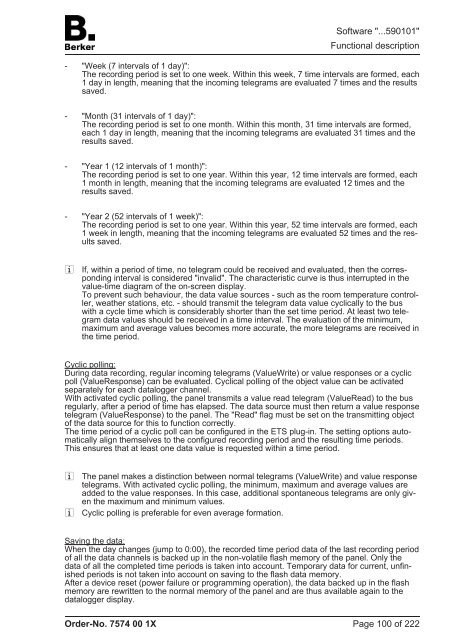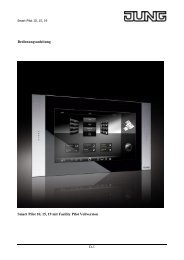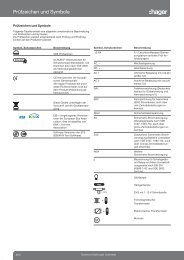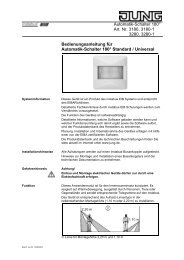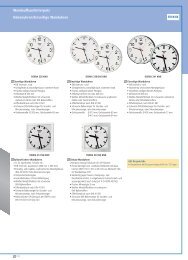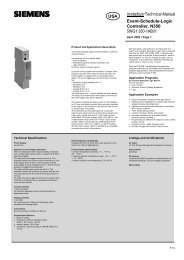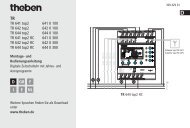You also want an ePaper? Increase the reach of your titles
YUMPU automatically turns print PDFs into web optimized ePapers that Google loves.
- "Week (7 intervals of 1 day)":<br />
The recording period is set to one week. Within this week, 7 time intervals are formed, each<br />
1 day in length, meaning that the incoming telegrams are evaluated 7 times and the results<br />
saved.<br />
- "Month (31 intervals of 1 day)":<br />
The recording period is set to one month. Within this month, 31 time intervals are formed,<br />
each 1 day in length, meaning that the incoming telegrams are evaluated 31 times and the<br />
results saved.<br />
- "Year 1 (12 intervals of 1 month)":<br />
The recording period is set to one year. Within this year, 12 time intervals are formed, each<br />
1 month in length, meaning that the incoming telegrams are evaluated 12 times and the<br />
results saved.<br />
- "Year 2 (52 intervals of 1 week)":<br />
The recording period is set to one year. Within this year, 52 time intervals are formed, each<br />
1 week in length, meaning that the incoming telegrams are evaluated 52 times and the results<br />
saved.<br />
i If, within a period of time, no telegram could be received and evaluated, then the corresponding<br />
interval is considered "invalid". The characteristic curve is thus interrupted in the<br />
value-time diagram of the on-screen display.<br />
To prevent such behaviour, the data value sources - such as the room temperature controller,<br />
weather stations, etc. - should transmit the telegram data value cyclically to the bus<br />
with a cycle time which is considerably shorter than the set time period. At least two telegram<br />
data values should be received in a time interval. The evaluation of the minimum,<br />
maximum and average values becomes more accurate, the more telegrams are received in<br />
the time period.<br />
Cyclic polling:<br />
During data recording, regular incoming telegrams (ValueWrite) or value responses or a cyclic<br />
poll (ValueResponse) can be evaluated. Cyclical polling of the object value can be activated<br />
separately for each datalogger channel.<br />
With activated cyclic polling, the panel transmits a value read telegram (ValueRead) to the bus<br />
regularly, after a period of time has elapsed. The data source must then return a value response<br />
telegram (ValueResponse) to the panel. The "Read" flag must be set on the transmitting object<br />
of the data source for this to function correctly.<br />
The time period of a cyclic poll can be configured in the ETS plug-in. The setting options automatically<br />
align themselves to the configured recording period and the resulting time periods.<br />
This ensures that at least one data value is requested within a time period.<br />
i The panel makes a distinction between normal telegrams (ValueWrite) and value response<br />
telegrams. With activated cyclic polling, the minimum, maximum and average values are<br />
added to the value responses. In this case, additional spontaneous telegrams are only given<br />
the maximum and minimum values.<br />
i Cyclic polling is preferable for even average formation.<br />
Saving the data:<br />
When the day changes (jump to 0:00), the recorded time period data of the last recording period<br />
of all the data channels is backed up in the non-volatile flash memory of the panel. Only the<br />
data of all the completed time periods is taken into account. Temporary data for current, unfinished<br />
periods is not taken into account on saving to the flash data memory.<br />
After a device reset (power failure or programming operation), the data backed up in the flash<br />
memory are rewritten to the normal memory of the panel and are thus available again to the<br />
datalogger display.<br />
Order-No. 7574 00 1X<br />
Software "...590101"<br />
Functional description<br />
Page 100 of 222


